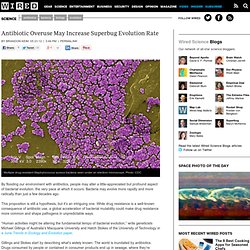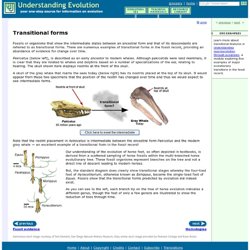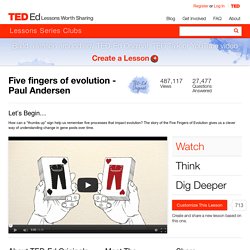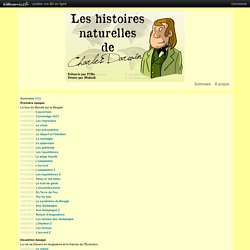

Biology 30 - Evolution Project. Evolution vs Natural Selection. Teaching evolution. Evolution of Cancer article. Video: How do we stop invasive species? (ScienceAlert) Pepper Moths - Home. Diseases - Manual - Activity 3, page 1. At a Glance Focus: Students investigate the growth of bacteria in the presence of antibiotics and use the results to explain a case of antibiotic-resistant tuberculosis, presented in an Internet-based interview.

Major Concepts: The re-emergence of some diseases can be explained by evolution of the infectious agent (for example, mutations in bacterial genes that confer resistance to antibiotics used to treat the diseases). Objectives: After completing this activity, students will be able to explain how antibiotic treatment results in populations of bacteria that are largely resistant to the antibiotic and describe inappropriate and/or questionable uses of antibiotics. Prerequisite Knowledge: Students should be familiar with bacterial growth and with evolution by natural selection.
Introduction In 1943, penicillin was introduced as the "magic bullet" for curing many infectious diseases. The primary reason for the increase in antibiotic resistance is evolution. Materials and Preparation 1. ICBL: Investigative Case Based Learning. SurvivaloftheSneakiest. Origami Birds. Teddy Graham Lab. Caminal Pictures. Caminal Lab Advanced. Antibiotic Overuse May Increase Superbug Evolution Rate. Multiple drug-resistant Staphylococcus aureus bacteria seen under an electron microscope.

Photo: CDC By flooding our environment with antibiotics, people may alter a little-appreciated but profound aspect of bacterial evolution: the very pace at which it occurs. Bacteria may evolve more rapidly and more radically than just a few decades ago. This proposition is still a hypothesis, but it’s an intriguing one. While drug resistance is a well-known consequence of antibiotic use, a global acceleration of bacterial mutability could make drug resistance more common and shape pathogens in unpredictable ways. “Human activities might be altering the fundamental tempo of bacterial evolution,” write geneticists Michael Gillings of Australia’s Macquarie University and Hatch Stokes of the University of Technology in a June Trends in Ecology and Evolution paper. Gillings and Stokes start by describing what’s widely known: The world is inundated by antibiotics. That much is obvious. Evoltion defined. Welcome to Evolution 101! 10 Vestigial Traits You Didn't Know You Had.
Evolution Timeline.
Evolution Interactive Games. Mechanisms. Speciation. Clipbirds. Cytochrome C Lab. Sexual conflict final. The pace of evolution. Videos that Take Evolution Education Up a Notch : Cornell Lab of Ornithology: BirdSleuth K-12. Cladograms. Dichotomous Keys. Natural Selection and Adaptation. The history of life: looking at the patterns. Transitional forms. Transitional forms Fossils or organisms that show the intermediate states between an ancestral form and that of its descendants are referred to as transitional forms.

There are numerous examples of transitional forms in the fossil record, providing an abundance of evidence for change over time. Pakicetus (below left), is described as an early ancestor to modern whales. Although pakicetids were land mammals, it is clear that they are related to whales and dolphins based on a number of specializations of the ear, relating to hearing. The skull shown here displays nostrils at the front of the skull. A skull of the gray whale that roams the seas today (below right) has its nostrils placed at the top of its skull. Note that the nostril placement in Aetiocetus is intermediate between the ancestral form Pakicetus and the modern gray whale — an excellent example of a transitional form in the fossil record!
Life Science. Learning Goals Which skull is a lizard and which is a snake?

During this session, you will have an opportunity to build understandings to help you: Define what is meant by “species.” Describe how new species evolve as a result of variation and adaptation through natural selection. Comprehend a tree of life as a model for depicting evolution and the relatedness of species. Video Overview What makes a snake a snake, and a lizard a lizard? Video Outline. Reproduction: One Goal, Two Methods : PBS LearningMedia. Welcome to Evolution 101! Classifying Life. Natural Selection - Natural Selection, Evolution, Mutation. How did feathers evolve? - Carl Zimmer. Evolution. The driving force for molecular evolution of translation. What are viruses? Microbe Clock. Five fingers of evolution - Paul Andersen. In his talk, Paul Andersen explains the five causes of microevolution.

Research one example for each cause in the human population. Use the following population simulator to simulate microevolution: Run the simulation using the default settings. Note the change in gene frequencies due to chance. Reset the simulation and increase the population size to 200. Run the simulation again and note the change in gene frequencies due to chance. LabBench. LAB_Evidence_of_Evolution. Becoming Human PBS Video question. Becoming Human. Darwin Webcomics. Webcomics.fr: publiez vos BD en ligne Connexion Darwin Sommaire RSS Première époque Le tour du Monde sur le Beagle 02/11/2010 Couverture 01/09/2009 Cambridge-1831 08/09/2009 Les reproches 15/09/2009 Le choix 22/09/2009 Les précautions 29/09/2009 Le départ et l'intuition.

Teaching evolution.